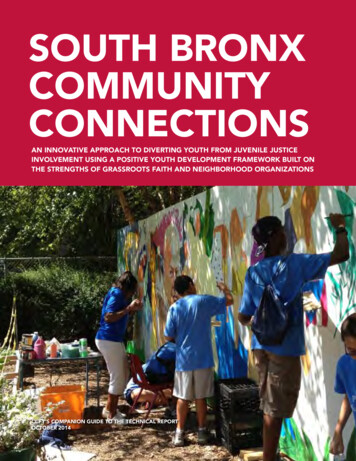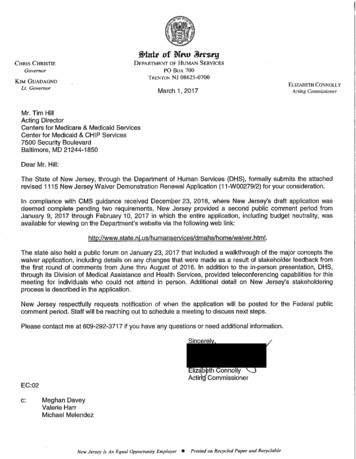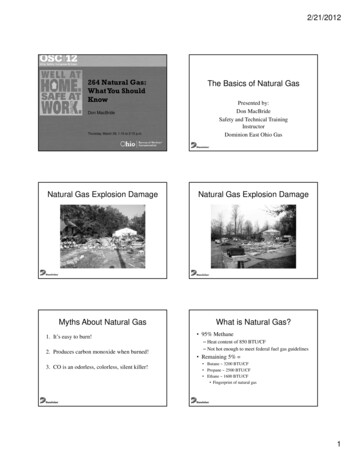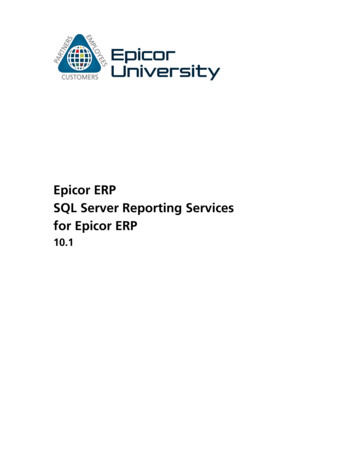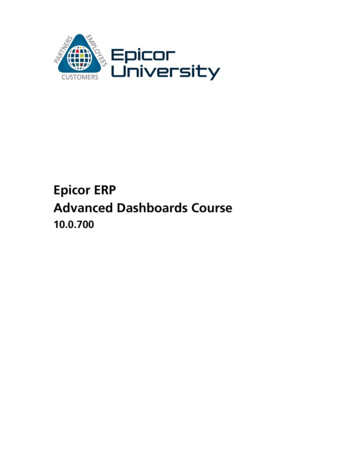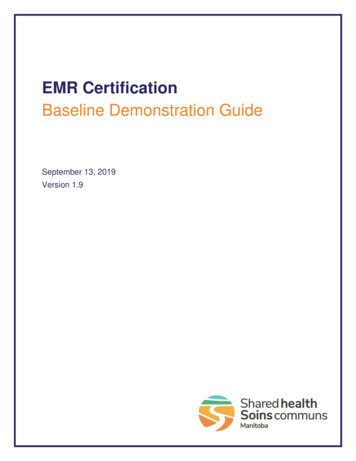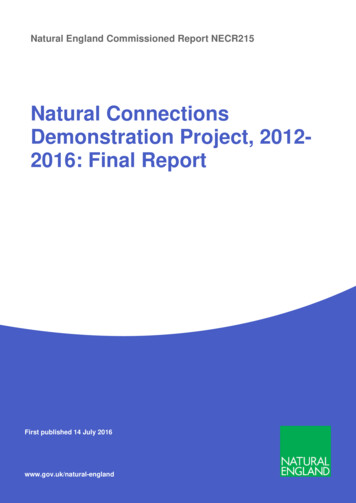
Transcription
Natural England Commissioned Report NECR215Natural ConnectionsDemonstration Project, 20122016: Final ReportFirst published 14 July 2016www.gov.uk/natural-england
Minister Rory Stewart forewordNatural England commission a range of reports from external contractors toprovide evidence and advice to assist us in delivering our duties. The views in thisreport are those of the authors and do not necessarily represent those of NaturalEngland.BackgroundWe learn to love nature as children, and ourcommitment to nature later in life - respecting it,protecting it, restoring it, or simply enjoying it, isbuilt on that childhood foundation. The naturalworld is good for us all, children and adults - forour health and souls, it is a bedrock of societyand the economy, and it matters for its ownsake.Last year, however, many thousands of childrenacross England never stepped out into pureenvironment, never even set foot on a localbeach, park or woodland. Tens of thousandsmore have never had a chance to build a senseof belonging, rooted in a local area. Our aimshould be not only to give all children thechance to experience the natural world, but alsoto understand it, and respond to it.This is not always easy. Some of us are luckyenough to fall in love with some particular part ofthe outdoors - with butterflies, or birds, or thehedgehog, and retain that love all our life.Others of us need some help, need to be taughtwhat to look for and need to be shown differentparts of nature before we find something toembrace. That is why outdoor education is soimportant for all of us.And that is also why I am delighted that Defra,with our partners at Natural England, HistoricEngland and Plymouth University haveaddressed outdoor education so systematicallythrough this project. They have carefullyexamined the barriers teachers face, reflectedon how teachers can get engaged in the naturalenvironment, and how outdoor learning can besustained in a school. And they have brought tolife some of the best examples of outdooreducation in the country.The project has proved just how valuable theoutdoors has been: rewarding and enjoyable forteachers, offering new avenues for learning andunlocking creativity. I was particularly struck byhow teachers are using the natural world, notsimply as a way of teaching botany orgeography, but as a way of teaching othersubjects - English in woodland and Maths on thebeach. And we shouldn't be surprised todiscover it is also encouraging betterattendance, reducing bullying and improvingpupil motivation for learning.These projects demonstrate that it takes realskill, and experience to turn the outdoors into aclassroom. But when it is done properly, as ithas been - triumphantly through the NaturalConnections project - the impact is incredibleand extraordinarily valuable. We owe a greatdebt of gratitude to all our partners, and to theteachers, families and pupils who participated inthis project. This is a model, which shouldinspire us right across Britain.This report should be cited as:WAITE, S., PASSY, R., GILCHRIST, M., HUNT,A. & BLACKWELL, I. 2016. Natural ConnectionsDemonstration Project, 2012-2016: Final Report.Natural England Commissioned Reports,Number215.
Natural England Project Team - Jim Burt, Principal Adviser, Outdoor Learning and Outdoors for AllProgramme jim.burt@naturalengland.org.uk and Caroline Emmerson, Senior Adviser, Outdoors for AllProgramme caroline.emmerson@naturalengland.org.ukContractor - Sue Waite, Associate Professor, Plymouth Institute of Education, Plymouth University, DrakeCircus, Plymouth, PL4 8AA s.j.waite@plymouth.ac.ukKeywords - natural connections demonstration project, natural connections, outdoor learning, learning in thenatural environment, learning outside the classroom, connection to nature, evaluationFurther informationThis report can be downloaded from the Natural England l-england. For information on Natural England publicationscontact the Natural England Enquiry Service on 0845 600 3078 or e-mail enquiries@naturalengland.org.uk.This report is published by Natural England under the Open Government Licence - OGLv3.0 for public sectorinformation. You are encouraged to use, and reuse, information subject to certain conditions. For details of thelicence visit Copyright. Natural England photographs are only available for non commercial purposes. If any otherinformation such as maps or data cannot be used commercially this will be made clear within the report.ISBN 978-1-78354-323-6 Natural England and other parties 2016
AcknowledgementsThe authors would like to thank:The project funders, the Department for the Environment, Food and Rural Affairs, NaturalEngland and Historic England, for commissioning the project. In particular we would like tothank Jim Burt and Caroline Emmerson from Natural England for their counsel and supportduring the project lifetime.The Project Board, who were much appreciated ‘critical friends’ to the project.Dan Corlett, CEO of Farming and Countryside Education, Tom Higginbottom and JohnRussell, who supported the web service element.Everyone who has worked on the Natural Connections project delivery from PlymouthUniversity and Natural England; Chris Burke, Emily Cannon, Katie Cole, Andy EdwardsJones, Jenny Hanwell, Helen Lawson, Jo Lewis, Laura Moore, Beth Summers, for theirenergy and enthusiasm. We are also grateful to other Plymouth University staff and studentswho contributed to the project, particularly Jennie Aronsson, Olivia Fakoussa, Judith Hopkins,Irene Kaimi, Matthew Jackson, Rana Moyeed, Paul Tiltman and members of the FinanceTeam.Natural Connections hub leaders for their dedication to the project and the huge amount oftime and energy they put into the project, above and beyond what they were contracted todo. They are: Plymouth City Council (Chris Avent, Martin Northcott, Zoe Sydenham, JemmaSharman); The Learning Institute (Nick Appleby, Pete Butts, Amanda Huggins); Lighting upLearning (Ed Drewitt, Nic Garrick, Sarah Payton); Mel Easter; Forest of Avon Trust (JonAttwood); the Real Ideas Organisation (Jonathan Clitheroe, Ben Gavan, Lucy Halliday, EdWhitelaw, Laura Woodger).School staff, volunteers and pupils in all Natural Connections schools for their enthusiasmand commitment to outdoor learning that made the Natural Connections project such asuccess. Their invaluable contributions to the evaluation have made this report possible andhelped shape future practice. A particular thank you goes to all those schools that hostedcase study visits and provided such wonderful insight into their work.All the other organisations and project partners who worked with the project and contributedwith generous in-kind support, time, resources and professional input.1
Contents1. Executive Summary . 5Figure 1: The pathway to raised attainment through outdoor learning . 102. Project Context. 133. Project Principles and Purpose . 153.1 Project principles . 153.2 Project elements . 163.3 Project purpose. 164. Project Delivery Model and Structure . 184.1 Distributed project delivery model . 18Figure 2: Project structure including number and type of schools recruited . 194.2 Successes of distributed project delivery model . 194.3 Challenges of distributed project model . 204.4 Summary of key findings and implications - distributed delivery model . 215. Evaluation Design and Methods. 225.1 Evaluation design . 225.2 Data collection and management . 23Figure 3: Overview of evaluation audience and research methods . 24Table 1: Research instruments. 255.3 Successes in evaluation . 265.4 Challenges with evaluation . 265.5Summary of key findings and implications – evaluation . 286. Results/Findings. 296.1 Project scale . 29Figure 4: Project areas . 306.2 Project reach: number of schools recruited and participation . 31Table 2: Number of schools recruited (n 125) . 316.3 Wider reach through communication activities. 316.4 Project management. 326.5 Central team . 336.6 Summary of key findings and implications – project management at central team level . 356.7 Brokerage – hub leaders . 35Table 3: Bristol hub leader model (Lighting up Learning, an educational consultancy) . 372
Table 4: Cornwall hub leader model (The Learning Institute, an educational service provider). 38Table 5: North Somerset hub leader model (Forest of Avon Trust, a Bristol based charitable organisationwith expertise in woodlands) . 39Table 6: Plymouth hub leader model (Plymouth City Council, the local authority for Plymouth) . 40Table 7: Torbay hub leader model (Real Ideas Organisation, and independent community interest companywith expertise in social enterprise in schools; Mel Easter, retired headteacher with extensive knowledge andexperience of LINE). 41Table 8: Number of potential project schools in hub areas . 456.8 Summary of key findings and implications – project management at hub level . 486.9 Volunteering. 49Figure 5: Number of volunteers in schools: total and those involved in LINE delivery. 506.10 Summary of key findings and implications – volunteering . 546.11 Participatory web service . 556.12 Summary of key findings and implications – on-line activity . 587. LINE in Schools. 597.1 Characteristics of schools recruited to engage with LINE . 597.2 Impact on LINE activity . 60Figure 6: Estimate of minutes of school LINE activity (per week per class). 60Figure 7: Increase in proportion of project school TAs, teachers and volunteers involved in LINE (all at pvalues 0.001) . 61Figure 8: Increase in proportion of schools with a positive staff attitude to LINE . 62Figure 9: Increase in proportion of schools with LINE in school documentation (p-value 0.01). 63Figure 10: Increase in proportion of schools with staff undertaking LINE-related CPD (p-value 0.05) . 64Table 9: Subset of 25 schools’ sustained increase in demand for LINE . 657.3 Scope of LINE in schools . 66Figure 11: Use of LINE for different curriculum areas (school activity logs) . 667.4 Challenges to LINE implementation . 71Figure 12: The five main school challenges to LINE . 727.5 Summary of key findings and implications – school implementation of LINE. 748. The Impact of LINE on Teachers and Pupils . 768.1 Impact on teachers . 76Figure 13: School assessment of LINE’s impact on teachers’ work . 778.2 Impact on pupils. 77Figure 14: School assessment of LINE’s impact on pupils . 783
Figure 15: The pathway to raised attainment through outdoor learning . 818.3 Summary of key findings and implications – impact of LINE on teachers and pupils. 869. Project Budget. 879.1 Budget successes. 889.2 Budget challenges . 889.3 Summary of key findings and implications – budget . 8810. Added Value. 8910.1 In-kind added value . 8910.2 Strategic partnership added value . 9010.3 Summary of key findings and implications – added value . 9111. Sustainability of Hub Delivery and Legacy . 9211.1 Central team . 9211.2 Hub leaders . 9211.3 Summary of key findings and implications – sustainability of hub delivery and legacy . 9512. Conclusion . 964
1. Executive SummaryBackgroundEvidence 1 commissioned to inform the Natural Connections Demonstration Project identifiedthat the fundamental challenges to learning outside the classroom in the natural environment(LINE) in schools were local and revolved around a lack of teacher confidence in teachingoutside and fragmentation of LINE service provision. These underpinned the moretraditionally cited challenges of curriculum pressures, concern about risks and cost.This and other evidence was used by Natural England and a wide range of partnerorganisations to shape the design of the demonstration project. The project was funded bythe Department for the Environment, Food and Rural Affairs (DEFRA), Natural England andHistoric England, commissioned by Natural England, and delivered in South West Englandby Plymouth University.Natural Connections was intended to: Stimulate the demand from schools and teachers for learning outside the classroomin the local natural environment. Support schools and teachers to build learning outside the classroom in the localnatural environment into their planning and practices. Stimulate the supply of high quality learning outside the classroom in the naturalenvironment services for schools and teachers.This report presents the key findings from the project. Further detail will be available inNatural England Commissioned Report (NECR) 215 Annex 1. A shorter guidance document,Natural Connections Demonstration Project: ‘Transforming Schools through OutdoorLearning' 2 that summarises the implications for practice will also be published.Distributed delivery model Plymouth University devised a distributed model of responsibility, operating at fourlevels:the central team hub leaders beacon schools cluster schools. The concept was to build local networks in which local brokerage agencies (‘hubleaders’) would first recruit and enhance the work of schools that were alreadydelivering LINE (‘beacon schools’) and who would, in turn, support other schools(‘cluster schools’) in developing their LINE practice. The aim was for a cultural shift in1Dillon, J. & Dickie, I. (2012). Learning in the Natural Environment: Review of social and economicbenefits and barriers. Natural England Commissioned Reports, Number 092.2Natural Connections Demonstration Project: ‘Transforming Schools through Outdoor Learning':Plymouth: Plymouth University. https://www.plymouth.ac.uk/research/oelres-net5
participating schools towards embedding LINE in their policies and embracing LINEas part of their everyday practice. The distributed model was successful in recruiting schools to the project, supportingthem to deliver LINE, and testing sustainable models of LINE delivery. A collaborative, partnership approach was fundamental to project success andbrought considerable added value at all levels.Hub delivery The project was delivered in South West England, with hubs established in areas ofmultiple deprivation in Bristol, Cornwall, North Somerset, Plymouth and Torbay. Thehub leaders also worked with schools outside these areas to capitalise on interest inthe project. Characteristics of a successful hub leader included:o alignment between the aims of the Natural Connections project and hubleader organisationo a thorough understanding of the education system and education networkso an enthusiasm for LINE and awareness of local LINE providers, includingCPD providers.School recruitment 125 schools were recruited and contributed to the evaluation. A further 65 schoolstook part in the project but did not contribute to project evaluation. Across the 125schools, the project engaged with:o 2,531 teacherso 2,492 teaching assistantso 40,434 students. Schools most likely to engage with LINE all displayed strong leadership and wereopen-minded about trying new things. Size of school, Ofsted grading, percentage ofpupils with special educational needs (SEN) or eligibility for free school meals (FSM)did not relate to whether schools were more or less likely to engage with LINE. Theability to recruit schools from a wide set of circumstances confirmed a key projectassumption that there is a latent demand for LINE among the school population. The125 project schools consisted of 106 primary, 9 secondary, 8 special and 2 allthrough schools (primary and secondary). The first year of this four-year project was needed to establish the central team, hubteams and beacon schools before widening school recruitment. The length of timeneeded to recruit and establish groups of 20-30 schools in hubs was around 12months. The optimum time to recruit schools was the summer term, allowing6
integration of LINE into plans for the new academic year. The majority of schoolsrecruited into the project were actively engaged for about 18 months. The most successful approach for recruiting and managing school participation wasfor hub leaders to enable groups of schools to operate flexibly, in ways that best metlocal needs without necessarily categorising schools as either beacon or cluster.LINE implementation in schools An extensive evaluation allowed deep insight to be gathered on projectimplementation and outcomes of LINE. School survey respondents reported statistically significant increases in the timespent on LINE activity across all school terms. Schools adopted many different models of LINE implementation, with anything from afew staff to many or all of the staff involved with LINE. In all cases, implementationwas dynamic and changed regularly as staff developed and broadened their LINEpractice. A pattern emerged in school survey comments in which schools: first,understood the benefits to pupils and teachers; second, increased levels of LINEactivity; and third, increased the regularity of LINE activity and embedded LINEpractice across the school. Schools invested time, goodwill, energy and funding in LINE. The characteristics thatunderpinned and reflected successful LINE implementation were:o creation of a positive staff culture towards LINE (including confidence andwider recognition and reward)o growth in school aspirations for LINEo enhancing teaching practice across the curriculumo collaboration and networking with other schoolso development of school grounds. Over 90 per cent of schools surveyed agreed that LINE was useful for curriculumdelivery. LINE was used across all curriculum areas, most regularly and consistently in thecore subjects of science, English, maths and PE. The percentage of maths lessonstaken outside showed a noticeable increase over the life of the project. Nostatistically significant increase in non-curricular LINE activities was reported,although case-studies demonstrated that schools valued these LINE activities fortheir contribution to the foundational aspects of learning.7
The most frequently reported challenges to LINE development in schools atrecruitment were:o staff lacking confidence in working outsideo staff uncertainty about linking LINE to the curriculumo lack of fundingo the need for volunteer supporto time. The first four challenges all reduced during the project lifetime, reflecting schools’developing understanding of how low-cost LINE could support school priorities andbe embedded into regular curricular and non-curricular activities. Time, as achallenge, increased over the project as teachers developed understanding of thetime needed to plan and deliver increasingly complex LINE practice. Reflecting the project assumptions, challenges to LINE were school specific andchanged during the course of the project. This was shown to be an ongoing processin which schools addressed immediate challenges and then, as confidence in LINEpractice developed, they identified new challenges. Results suggest that an initialaudit and priority assessment to develop a school action plan for LINE, followed byregular reviews, would help to identify and address solutions to particular issues asthey changed over time. Project schools chose to focus on building in-house responsibility and capability forLINE, generally within school grounds rather than in local green spaces withinwalking distance. Engagement with LINE provider services did not changesignificantly over the project, although some schools reported an increase in demandfor services, including those to support CPD and school grounds development. CPD was central to delivery of the Natural Connections project. Its role was tosupport school staff in:o developing knowledge, understanding and practice of LINEo giving confidence in the efficacy of LINE, thereby supporting efforts to embedLINE and to shift the school teaching and learning culture to one thatembraced LINEo addressing practical challenges such as funding, grounds development andhealth and safety requirements. There was a small but statistically significant increase in the proportion of volunteersinvolved in LINE across project schools. Project findings show that the resource tosupport volunteer development needs to be flexible because schools tended to buildtheir confidence in LINE before considering the additional demands of supportingvolunteers.8
The project confirmed the need for a broad multi-platform media strategy that wasresponsive to the needs of schools. Collaborative development of on-line resources,designed by local LINE practitioners for local LINE practitioners emerged as the mostlikely ways to successfully support delivery. In addition low-cost, responsive socialmedia such as Twitter and blogs were useful for disseminating information. Gathering evaluation and reporting data from schools required considerable effort.This was assisted by promoting baseline surveys as a means to inform the actionplanning needed to support schools with their LINE.Impacts of LINE Reflecting the insight research 3 and project assumptions, the results confirmedincreases in all the positive outcome areas assessed, for both teachers and pupils. Positive impacts for teachers. The following proportions of schools agreed that LINEhad a positive impact on:o teaching practice (79 per cent)o health and wellbeing (72 per cent)o professional development (69 per cent)o job satisfaction (69 per cent)o teaching performance (51 per cent). Positive impacts for pupils. The following proportions of schools agreed that LINEhas positive impacts for pupils:o enjoyment of lessons (95 per cent)o connection to nature (94 per cent)o social skills (93 per cent)o engagement with learning (92 per cent)o health and wellbeing (92 per cent)o behaviour (85 per cent)o attainment (57 per cent). Pupil feedback reflected teacher feedback, with 92 per cent of pupils surveyedagreeing that they enjoyed lessons outside and 89 per cent agreeing they felt happyand healthy in lessons outdoors.3Rickinson, M., Hunt, A., Rogers, J. & Dillon, J. (2012). School Leader and Teacher Insights intoLearning Outside the Classroom in Natural Environments. Natural England Commissioned Reports,Number 097.9
In the surveys, a majority of schools (57 per cent) attributed a direct positive impactof LINE on pupil attainment, significantly more than those who thought it had noeffect. Teachers in case-study interviews reported having more confidence that LINEcontributed to attainment than was indicated by quantitative surveys. Many case-study schools reported that they engaged with LINE for reasons that wererelated to supporting attainment and character development, including improvingbehaviour, social skills, health and wellbeing and engagement with learning. All ofthese were cited as foundational to successful learning. Interviewees from casestudy schools emphasised that they also valued LINE for enabling wonder, creativity,support for particular concepts and br
A. & BLACKWELL, I. 2016. Natural Connections Demonstration Project, 2012-2016: Final Report. Natural England Commissioned Reports, . Natural Connections hub leaders for their dedication to the project and the huge amount of time and energy they put into the project, above and beyond what they were contracted to .
